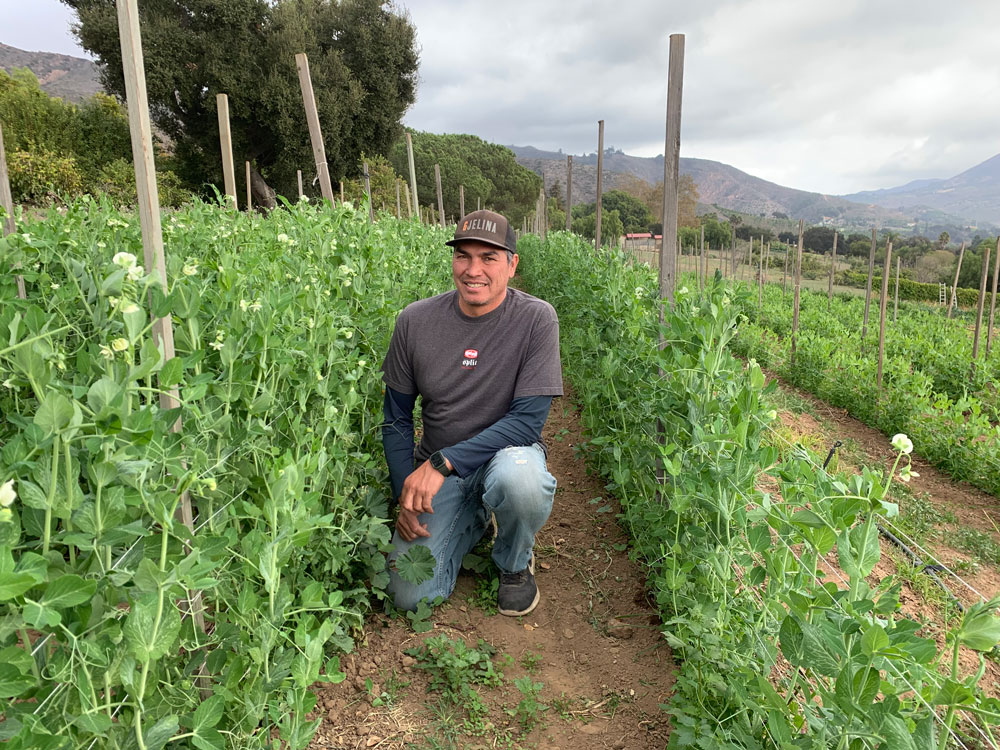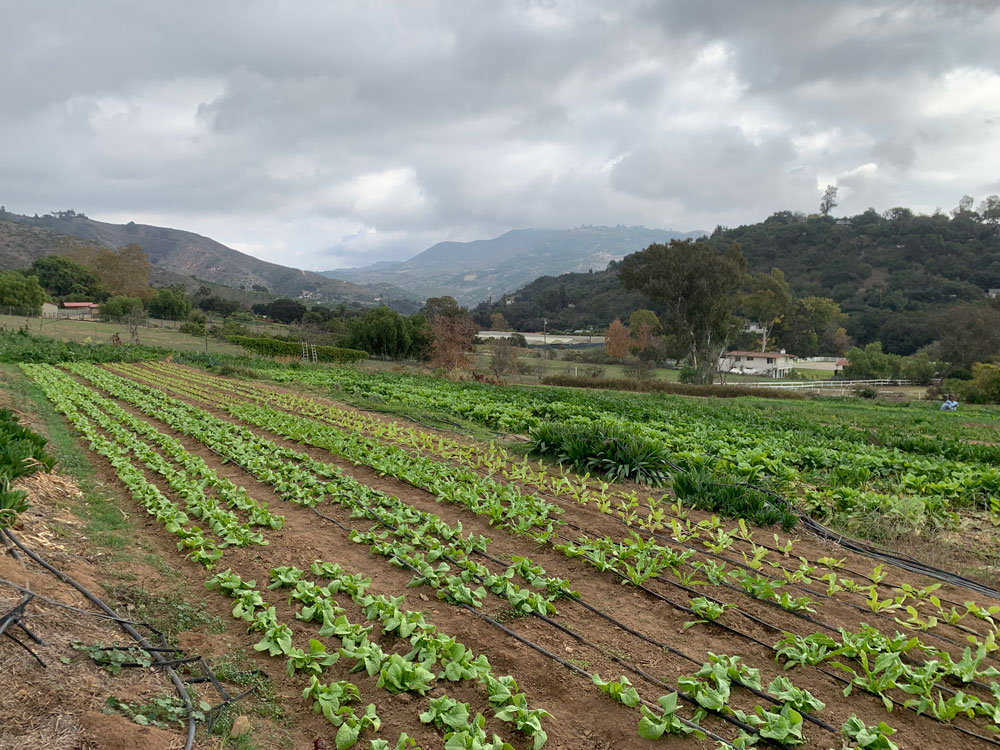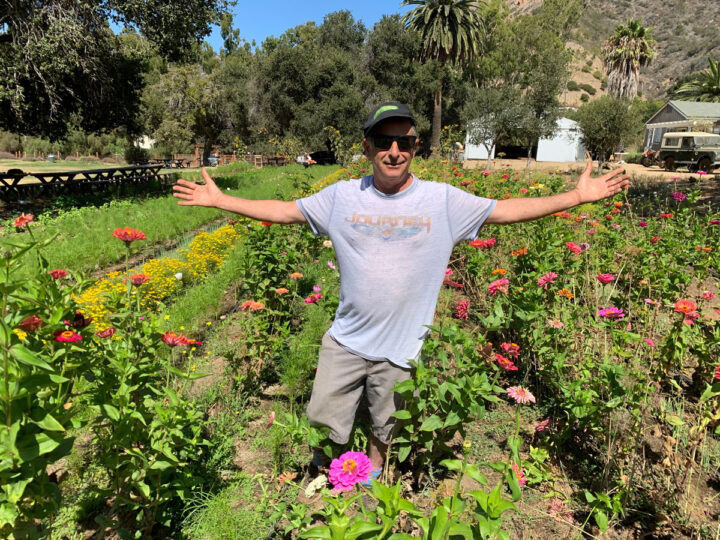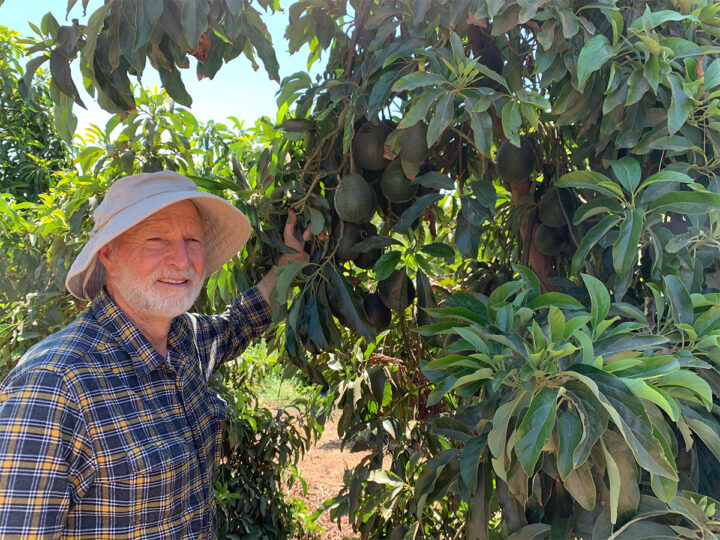The Coleman Family homefarm is tucked deep into the coastal mountains outside of Carpinteria, a kind of utopian redoubt as much as it is a farm. There’s no sign or gate; the gravel lane runs past a horse farm and then into a sandy two-track and then just runs out altogether at the top of the hill, where I got out of the car to take a look.
Lined out across a gentle slope were thick rows of French sorrel and some cardoon or artichoke thistle coming on, with a modicum of weeds between patches that come with growing chemical-free. There was also the anise-flavored herb hoja santa and sword-leaf lettuce – I was in the right place. Not too many farmers grow these rare greens and herbs in any quantity, but Coleman Family Farms has made a reputation by their commitment to unique tastes over the last 60 years. More than that, their daring produce has shaped the way many Americans eat.
It was an overcast day in November 2022, and seabreezes washed over the unadorned six-acre spread. It sits just a few miles inland from the Pacific Ocean at Rincon Point and right up against the Los Padres National Forest, an ideal microclimate for great greens and isolated from big commercial farms – and just about everything and everyone else, for that matter.

Romeo Coleman in the peas, November 2022. A couple good pea crops paid for the land when his father started Coleman Family Farms in the 1960s.
Romeo Coleman called to me from the house, which I hadn’t seen tucked away behind a garage and some citrus trees. Tall and smiling, a familiar figure to chefs and farmers’ market shoppers as the face of Coleman farms, he said, “Lunch is on the table, so come on inside.”
Romeo’s mother, Delia, was in the kitchen serving up some steaming bowls of Filipino pork adobo, and we immediately started talking about what she was cooking, what was coming in now from the farm, and how our lives orbited around food.
“It’s at the center of everyone’s life,” she said.
“There are very few other things you do three times a day,” added Romeo.
The house is like a big round wooden lodge, mostly one huge room with a few smaller rooms walled off to one side. A long table runs through it, made to accommodate the six grown Coleman children, their spouses and all the grandchildren and great-grandchildren (they don’t all quite fit). The big table seemed to dwarf the three of us as we sat down to the pork dish and some steamed rice, sautéed bok choy, sliced avocado – the last of the season from their old tree – and pickled French breakfast radishes. A simple feast that was the most perfect thing in the world.
We started talking about how this hideaway farm had strongly influenced our ideas about eating in California, and subsequently worldwide. Romeo’s father, Bill Coleman, was a legendary character whose brave experimentation in the field helped drive the idea of eating locally grown produce and designing menus around what is in season – a way of eating now called Farm-to-Table, but which was known in the 1970s as “California Cuisine.”
Bill bought this farm in 1963, when it was six acres of lemons and avocados, and he tore out most of the trees and started growing China peas – snow peas – which was economically risky. Helen Brown’s West Coast Cookbook, which advocated cooking with produce and spices grown in the neighborhood rather than whatever iceberg lettuce or frozen spinach were available at the supermarket, had come out in 1952 but hadn’t yet gelled as a movement. Bill was still working at the family business in Santa Barbara, Coleman Building Materials, but he got lucky and had a couple great seasons selling snow peas to local restaurants and actually paid off the property. Couldn’t happen today.
As he went deeper into greens, his produce gradually caught the attention of home cooks and chefs interested in these new tastes he was bringing. He and Delia went full-time into farming in 1979 and helped launch the Santa Barbara Farmers’ Market, where they were credited with introducing so many products to the area, including arugula, mizuna, broccoli spigarello, endive, radicchio, Chioggia beets and previously little-known varieties of common herbs such as Peruvian black mint. They offered South African kei apples, mouse melons or Mexican sour gherkins, Jerusalem artichokes or sunchokes, and fenugreek when no one else had them. Bill capitalized on his farm’s microclimate by growing 14 different varieties of lettuce. He promoted cooking with native herbs purslane and lambsquarter, which most farmers still discard as weeds. Turning his attention to LA’s hunger for better produce, Coleman Family Farms became a regular at the Santa Monica Farmers’ Market around 1982 and is still there today.
California Cuisine was really born in Northern California, when Alice Waters launched Chez Panisse in 1971 and Sally Schmitt further expanded the idea of local ingredients with The French Laundry in 1978. But Wolfgang Puck championed the style in Los Angeles, putting all manner of produce on his pizzas, and his chef de cuisine at Spago, Mark Peel, pushed this farmers’ market-inspired cooking to include everything on the menu from beets to beef when he and his then-wife, chef and baker Nancy Silverton, opened Campanile in 1989. That legendary LA restaurant regularly featured Coleman’s produce, which was then well-known in restaurants around town, alongside its custom-butchered meats and artisanal breads and pastries.
The Coleman family’s commitment to diverse and local provisioning helped drive the movement to eat whatever it is that comes off the farm – like we all did before the idea of industrial food took hold – and that dining strategy then reignited interest in local cuisines around the globe.

Romeo is the farmer now, after his father passed away in 2017. At the homefarm and a 12-acre patch he works just east toward Ojai, he carries on growing an astonishing array of crops with just three hired hands. I think he’s still the only guy around growing celtuce, for instance, a delicious variety sometimes called stem lettuce or celery lettuce.
“Being a small farmer, we grow a little bit of everything,” Romeo said. “If a crop goes bad, you have other avenues for income. That diversity also helps with keeping beneficial bugs around or rotating crops or keeping disease from the soil.
“We have herbs, we have perennials, we have annuals, we have fruit trees, lots of lettuce throughout the year. Kale’s just coming on now. Spigarello. We do a lot of different stuff. Bok choy.”
He points out that his father was mostly Scottish, but his mother Delia is Filipina, and Bill learned a lot of his methods from other Filipino farmers in Santa Barbara.
“He used to go to those old Filipino farmers,” Delia said, smiling. “Hang out with them. He loved them.”
“He learned a lot from the old Filipino farmers,” Romeo nodded. Bill’s obituary in the Santa Barbara Independent names some of those farmers, local legends, and notes that through them he learned the Filipino concept of Sakop, or family circle.
“In Montecito, the Hammond property; an old couple Filipinos used to farm that Hammond property for a long time,” Delia added. (This was possibly Bluebird Ranch, just inland from what is now Hammond Beach, where the Hammonds raised vegetables, ran a dairy and kept 3000 chickens.)
None of Romeo’s five siblings chose to go into farming. The first two, Basilio and Abraham, are from Bill’s first relationship, and Delia is mother to Romeo, Rizal, Santiago and their only sister, Ligaya. They all went to college and have good jobs and are doing “real well,” Romeo notes. His brother Abraham often works the Santa Monica Farmers’ Market with him: “It’s just his release, to chill out and be social.”
All six kids grew up on the farm, and Bill had an arrangement with them: in the summer, they had to work the farm half-day, then they could go to the beach. The rest of the year, if they weren’t playing sports after school, they worked the farm. So of course they all played sports. Romeo, who is tall and powerfully built, played some college football, and his youngest brother was a wide receiver at USC.
Romeo is proud of his rough-and-tumble family. At the Santa Monica market I once overheard him talking with a customer who jokingly suggested that he and Romeo should wrestle. Romeo was tossing heavy crates of produce around like they were full of air and he shot back, “I have four brothers that are all as big as me. You ready?”
Even though his siblings don’t work the farm, the life keeps calling to them, he said. “They do miss it. Being out here on the farm and being able to put your hands in the dirt.”
I mentioned that he seemed to love it, and he replied. “I do like it. When I saw that my dad and mom raised six kids off of farming and paid all their bills, good citizens, and still had some fun, then I figured I could do it, raising two kids. So I’ve been able to do it. There’s been times where it’s been hard, but always learning. Right Mom?”
“Yup,” she quipped. “When he was in his first year in college at San Luis Obispo, he was going to take child psychology and then I guess we were getting too old, lifting things in the market. And then all of a sudden he said, ‘I’m not going to school. I’ll finish it, but then I want to take over.’ And his father was so happy when he said that.”
Romeo’s father, Bill Coleman, was a legendary character whose brave experimentation in the field helped drive the idea of eating locally grown produce and designing menus around what is in season.
The Colemans built a life and a community around food and family – the Sakop – and when I mentioned that I really liked the unusual design of their big, wide-open house, both Delia and Romeo jumped in and told me that the chefs and diners who love their produce also went out of their way to build them this house.
In 2001, a freak fire burned down the house in which all the Coleman kids grew up. They had just put a new kitchen in the house and it seems an electrical surge went through the new tie-in and it malfunctioned and started a fire. The house was a total loss.
When word of this got to the people who had come to rely on Coleman produce, they went into action. Nancy Silverton and Mark Peel of Campanile put together a great fund-raiser involving what Romeo remembers as about 16 or so other chefs, some of them from restaurants that no longer exist today. On a single night in early 2002, the chefs got to work and raised enough money to buy most of the materials for a new home.
“A lot of restaurants, they help us in making this,” said Delia.
“They raised a lot of money,” Romeo said. “It was mostly for materials and the crew, because we knew people that were contractors, and they donated their time to manage their crews, and we would pay their crews and pay for all the material.”
Only Bill, Delia and one of Romeo’s younger brothers were living at home by that time, so rather than rebuild with a bunch of rooms, they designed a kind of roundhouse – wide open, with a tall center like a circus tent, all in beautiful wood.
“It’s more open,” said Romeo.
“Because when you’re cooking, everybody goes in the kitchen,” nodded Delia.
“So you make the whole place the kitchen,” I said.
“You just make a kitchen and a dining table,” said Delia.
“A big kitchen, yeah,” said Romeo.

As we finished our lunch, Romeo said his big challenges were access to land and water. Pretty much the same for every farmer everywhere right now. When he first started out farming, he was renting extra pieces of land here and there, but changing location year to year. That’s no way to get the soil in the kind of shape you need, and you’re constantly moving your equipment. Now he has the 12 acres near Ojai where he can stay put.
“The second thing is the water,” he added. “As water gets more and more scarce, it’s just going to be harder and harder.”
They run off an agricultural well at the homefarm, and the place is right up against the Los Padres National Forest, so the aquifer there is still in pretty good shape. But more and more non-farming homes appear in these mountains every year and the water slips away.
“The other field we run off of Lake Casitas, which is a municipal water system, and around seven years ago, they started rationing water basically, giving you a certain allotment of water based on your previous consumption of water. The first year they cut 10% and then the third year they cut a little bit more, and then the fourth year they cut a little bit more.”
Further cuts planned for 2023 were delayed by the recent wet winter, but even at his current allotment, Romeo figures that his operation in Ventura is sustainable for about another 15 years. Maybe we’ll get lucky and get a lot of rainy winters. But in the meantime, he’s been changing his planting and harvest schedules to maximize the availability of water.
He notes that people have not started pulling citrus and avocado trees in his area, at least not in the numbers they are down by Peter Schaner’s farm in San Diego County. But changes are needed in the amount of water allotted to farmers, and how much they have to pay for it.
“And what about Montecito?” Delia interjected. “They talk about water and all that, and yet they keep building and building and building.”
“Water consumption needs to be changed. And people that can afford it have to consume their water differently because… Yeah, don’t get us started,” Romeo said, flashing his huge smile.
New homes in the area are often built with solar pre-installed, he points out, but then they’ll lavish the property with incredibly dense and expensive landscaping, mostly with very thirsty non-native plants that suck up all the available water.
I note that we’ll probably have to legislate that at some point, even though no one wants that intrusion. But it’s either that, or –
“Yeah, or we don’t eat,” said Romeo.
Of course, the Colemans’ organic methods – and especially composting – develop soil that requires less irrigation, produce less runoff, and keep more water in the aquifer. The inputs are less all the way around, just like delivering straight to eaters cuts down on the environmental costs of processing and shipping, including greenhouse gas emissions. That was part of the point when Bill started raising produce pesticide-free and herbicide-free in the 1960s, developing healthy living soil and growing for flavor.
“Just before 2000, California state was trying to make it where you have to be certified to be able to say you’re organic, use the word. And we decided not to because we do the farmers’ markets and we sell directly to customers. We don’t ship, where you have to include the piece of paper that says certified. So since we were sticking with face-to-face customer interaction, we just decided not to,” said Romeo.
“We just said, ‘Come to the farm or just take our word,’” said Delia. “We’ve been raising vegetables organically even before that word was popular.”
She points out that a lot of folks still really haven’t made the connection between the way they live and the availability of resources like water. They want the green lawn. They want the tomato in January. For 60 years, the Coleman farm has been teaching another reality.
“We still have seasons,” said Romeo. “Educating people around that is interesting.”
“This is the last avocado from our tree,” said Delia, motioning to the almost-empty plate.
“The last one?” I said, taking another slice.
“Those are the last ones,” Romeo nods, getting up. For now, anyway. Until the season comes back around, when we’ll all be really craving avocado again.
As we step outside to take a look around the farm, Romeo points out that even farmers themselves have seasons.
“I’ve been fortunate to do this, and I’m able to make a living off of it and pay my bills. And my kids have shoes on their feet and clothes on their back and able to eat. That’s been good, so hopefully one of the grandkids or great-grandkids or somebody in the family takes it over and they’re able to do the same. Then that would be a full circle of sustainability right there.”
— Dean Kuipers


